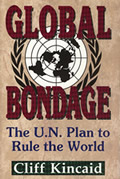Other
Cuddy
Articles:
Sept. 11:
Hold Government
Accountable
An
Economic Assault on
African-Americans and Others in The US
WHAT IS THE ROLE OF IRAN?
Part 1
By
Dennis L. Cuddy, Ph.D.
February 27, 2006
NewsWithViews.com
For many years, one has heard of an 1871 plan of Albert Pike (Luciferian) and Giuseppe Mazzini (Italian revolutionary referred to as an "established point of light when rays traversed the world") to overthrow all religious and monarchical authority. It called for 3 world wars, the third of which would be between Islam and the Judeo-Christian West. There has been much debate over whether this plan was a hoax because author William Guy Carr learned of it from the writings of Cardinal Caro y Rodriguez of Chile in the 1920s, which would be after the First World War and in anticipation of the Second World War. However, most researchers have not bothered to find out that Cardinal Rodriguez referred to 2 French books from the 1890s---BEFORE any world war occurred ! In one of them, LE PALLADISME (1895) by Domenic Margiotta, Pike is referred to as "the Great Luciferian Pontiff," and the author relates that Pike wrote a pamphlet describing a "project of universal destruction" in which the religions of the world, including Islam, would literally war against each other.
Margiotta also reveals that according to Pike's plan, "There are also the outcasts, the miserable ones, several millions of free-thinking deists, and 2 million atheists, dedicated by the great Luciferian Pontiff to the reprobation of the sect, threatened by complete extermination or by complete conversion to the religion of the 'True Light' (Lucifer)." The original Pike pamphlet has not been found, but we know that this sounds like Pike, because in both his MORALS AND DOGMA (1871) and INDO-ARYAN DEITIES AND WORSHIP (1872), he praised Lucifer and on page 817 of MORALS AND DOGMA he opined that "The Papacy and the rival monarchies...tomorrow, perhaps, will destroy each other....The world will soon come to us for its Sovereigns and Pontiffs. We shall constitute the equilibrium of the Universe, and be rulers over the Masters of the World."
Since Muslims (among others) were part of the Pike plan, it is important to look at what the role of Iran might be in bringing about a global conflagration, since an Iranian sect today believes such a conflict could bring the Mahdi (a Muslim prophet who is supposed to appear before the end of the world). In an article, "Later than we think" (THE WASHINGTON TIMES, February 6, 2006), Arnaud de Borchgrave explained that Iranian "President Mahmoud Ahmadinejad's Shiite creed has convinced him lesser mortals can not only influence but hasten the awaited return of the 12th Imam, known as the Mahdi. Iran's dominant 'Twelver' sect holds this will be Muhammad Ibn Hasan, the righteous descendant of the Prophet Muhammad. He is said to have gone into 'occlusion' in the 9th century, at age 5.
His return will be preceded by cosmic chaos, war, bloodshed and pestilence. After this cataclysmic confrontation between the forces of good and evil, the Mahdi will lead the world to an era of universal peace....President Ahmadinejad reckons the return of the Imam, AWOL for 11 centuries, is only two years away. Mr. Ahmadinejad is close to the messianic Hojjatieh Society, which is governed by the conviction the 12th Imam's return will be hastened by 'the creation of chaos on Earth'." An attack on Iran would also certainly drive oil prices up, plus the leaders of Iran could also send thousands of suicide bombers into Iraq to create even more chaos in that country. Regarding the chaos in Iraq, one might want to reflect upon the description of "chaos theory" in SPIRITUAL POLITICS: CHANGING THE WORLD FROM THE INSIDE OUT by Corinne McLaughlin and Gordon Davidson (who worked for Lucis Trust, formerly Lucifer Publishing), in which they revealed that "at the heart of the most random or chaotic event lies order, pattern, and causality, if only we can learn to see it in a large enough context."
There is no evidence that Albert Pike was ever a close personal friend of Cecil Rhodes, but at about the same time Pike developed his plan which he shared with Mazzini, a young Cecil Rhodes began to develop his own plan for a secret Society of the Elect "to take the government of the whole world," in Rhodes' own words. And since those carrying out Rhodes' plan would come to control British foreign affairs for decades, it is worth examining Britain's role in promoting a pan-Islamist movement, especially pertaining to Iran and Iranians. The radical Islam of the Iranian mullahs today traces its origin back through the Muslim Brotherhood (founded in Egypt in 1928) to the 1870s.
According to Robert Dreyfuss in DEVIL'S GAME: HOW THE UNITED STATES HELPED UNLEASH FUNDAMENTALIST ISLAM (2005), "from the 1870s to the 1890s, Jamal Eddine al-Afghani (an Iranian) was supported by the United Kingdom." Afghani in 1885 proposed the idea of a British-led pan-Islamic alliance, and "in 1882, in India, according to a secret file of the Indian government's intelligence service---Afghani officially offered to go to Egypt as an agent of British Intelligence." Afghani formed many secret societies, and his chief disciple was Egyptian pan-Islamic activist Mohammed Abduh. Abduh's ideas were promoted in Egypt in THE LIGHTHOUSE magazine, which influenced Hassan al-Banna, founder of the Muslim Brotherhood in Egypt.
After the British literally took control of Egypt in 1881, Flora Shaw in 1886 went there as a correspondent for William Stead's PALL MALL GAZETTE. Stead was a confidante of Cecil Rhodes, and both Rhodes and Shaw (and Gandhi) were disciples of John Ruskin, who wrote of the British that "We are still undegenerate in race; a race mingled of the best northern blood." Ruskin also espoused a Socialist doctrine in TIME AND TIDE (1867), with greater Government authority over the people. Stead introduced Shaw to Rhodes in 1889, two years before Rhodes' secret society was formed, and Shaw became an ardent supporter of Rhodes' dream.
Upon Rhodes' death, his plan was implemented by Lord Alfred Milner, whose allies controlled British foreign affairs for decades. One of Milner's allies, Sir Edward Grey, misled the German Ambassador to England into thinking Britain would not enter the conflict over the assassination of Archduke Franz Ferdinand, thereby leading to the First World War in 1914. In the MONTREAL GAZZETTE (September 11, 1912) is related by Abdul-Baha that "the time is less than two years hence" when "a tiny spark will set the world ablaze." Abdul-Baha was the leader of the Baha'i, which promotes world government and one common faith. The Baha'i religion was founded in Iran by Baha Ullah, known as the "Point" or "Unity" who spoke of a United Nations of the World as early as 1860. And according to Robert Dreyfuss in DEVIL'S GAME, the Baha'i religion has been accused of having ties to British Intelligence, with Abdul-Baha knighted by the British government.
Before World War I, the British had already helped the family of Ibn Saud create the first fundamentalist (Wahhabi) Islamic nation of Saudi Arabia, and helped install Hashemites as kings of Iraq and Jordan. After the First World War, Sir Percy Cox in November 1922 drew up what became the Iraq-Kuwait border, which deliberately did not allow Iraq access to the sea, so it would remain dependent upon Britain. This would play an important part in Iraq's resentment toward the West and Kuwait, which helped to cause recent conflicts in that region.
After the Second World War, the pan-Islamic Muslim Brotherhood was used by British Intelligence (MI6) and the CIA against nationalist leaders Gamel Abdel Nasser in Egypt and democratically elected Mohammed Mossadegh in Iran. When Mossadegh nationalized Iranian oil in the early 1950s, the British and CIA funded his overthrow in August 1953 with the help of Ayatollah Seyyed Abolqassem Kashani, and reinstalled the Shah of Iran. The U.S. then in 1978 removed from power the Shah, who was succeeded by Ayatollah Ruhollah Khomeini, who had been mentored by Kashani.
In 1979, President Jimmy Carter's National Security Adviser Zbigniew Brzezinski thought he could use the Iranian government, including the Iranian Shiite mullahs as part of an "arc" of resistance from Egypt eastward against Soviet expansionism. When "students" supported by Khomeini took over the U.S, Embassy in Tehran, Iran, it presented a crisis. However, as Robert Dreyfuss notes: "Along with the threat from Khomeinism, some U.S. policy makers also saw opportunity...using the Islamic right to undermine the Soviet Union in its own empire, deep in Central Asia....The twin Islamic movements in Iran and (Muslim Brotherhood linked organizations like Al Qaeda in) Afghanistan, inspired Brzezinski and Bill Casey (President Reagan's CIA director) to pursue the Islam-in-Asia ('arc-of-Islam') theme aggressively."
Brzezinski developed a plan of financial and other support for Afghanistan hoping to lure the Soviets into involvement in a quagmire there, and the Soviets invaded in December 1979. After this, Zalmay Khalilzad (current U.S. Ambassador to Iraq), a neoconservative RAND strategist, wrote a paper explaining "the Khomeini regime also poses risks to the Soviets. The change of regime has encouraged similar movements in Iraq and Afghanistan, and might even affect Soviet Muslim Central Asia."
Perhaps it is useful at this time to remember that according to a 1952 map prepared by the World Association of Parliamentarians for World Government meeting in London in 1952, when the World Government comes into being, U.S. forces would be patrolling Central Asia (e.g., Kazakhstan, Uzbekistan, etc.). Brzezinski at Mikhail Gorbachev's first State of the World Forum in 1995 said: "We cannot leap into world government through one quick step. A consensual global system requires a process....The precondition for eventual and genuine globalization is progressive regionalization because by that we move toward larger, more stable, more cooperative units." This is the same strategy proposed by Cecil Rhodes' Association of Helpers member P. E. Corbett in POST-WAR WORLDS (1942).
|
Subscribe to the NewsWithViews Daily News Alerts! |
Relevant to this, the Bank for International Settlements (BIS, the world's central bank for all nations' central banks) produced in 2003, Paper No. 17, "Regional Currency Areas and the Use of Foreign Currencies." The BIS has been promoting the "Amero" as the currency for a North American Monetary Union, first proposed in 1999 by the Fraser Institute of Canada. The ultimate goal of the power elite is to link all regional economic arrangements into a single global system with one global currency which, according to THE ECONOMIST (January 9, 1988), will be around 2018 A.D. and called the "Phoenix." For part 2 click below.
Click here for part -----> 1, 2, 3,
� 2006 Dennis Cuddy - All Rights Reserved
Sign Up For Free E-Mail Alerts
E-Mails are used strictly for NWVs alerts, not for sale
Dennis Laurence Cuddy, historian and political analyst, received a Ph.D. from the University of North Carolina at Chapel Hill (major in American History, minor in political science). Dr. Cuddy has taught at the university level, has been a political and economic risk analyst for an international consulting firm, and has been a Senior Associate with the U.S. Department of Education.
Cuddy has also testified before members of Congress on behalf of the U.S. Department of Justice. Dr. Cuddy has authored or edited twenty books and booklets, and has written hundreds of articles appearing in newspapers around the nation, including The Washington Post, Los Angeles Times and USA Today. He has been a guest on numerous radio talk shows in various parts of the country, such as ABC Radio in New York City, and he has also been a guest on the national television programs USA Today and CBS's Nightwatch.
E-Mail: Not Available
There is no evidence that Albert Pike was ever a close personal friend of Cecil Rhodes, but at about the same time Pike developed his plan which he shared with Mazzini, a young Cecil Rhodes began to develop his own plan for a secret Society of the Elect...













